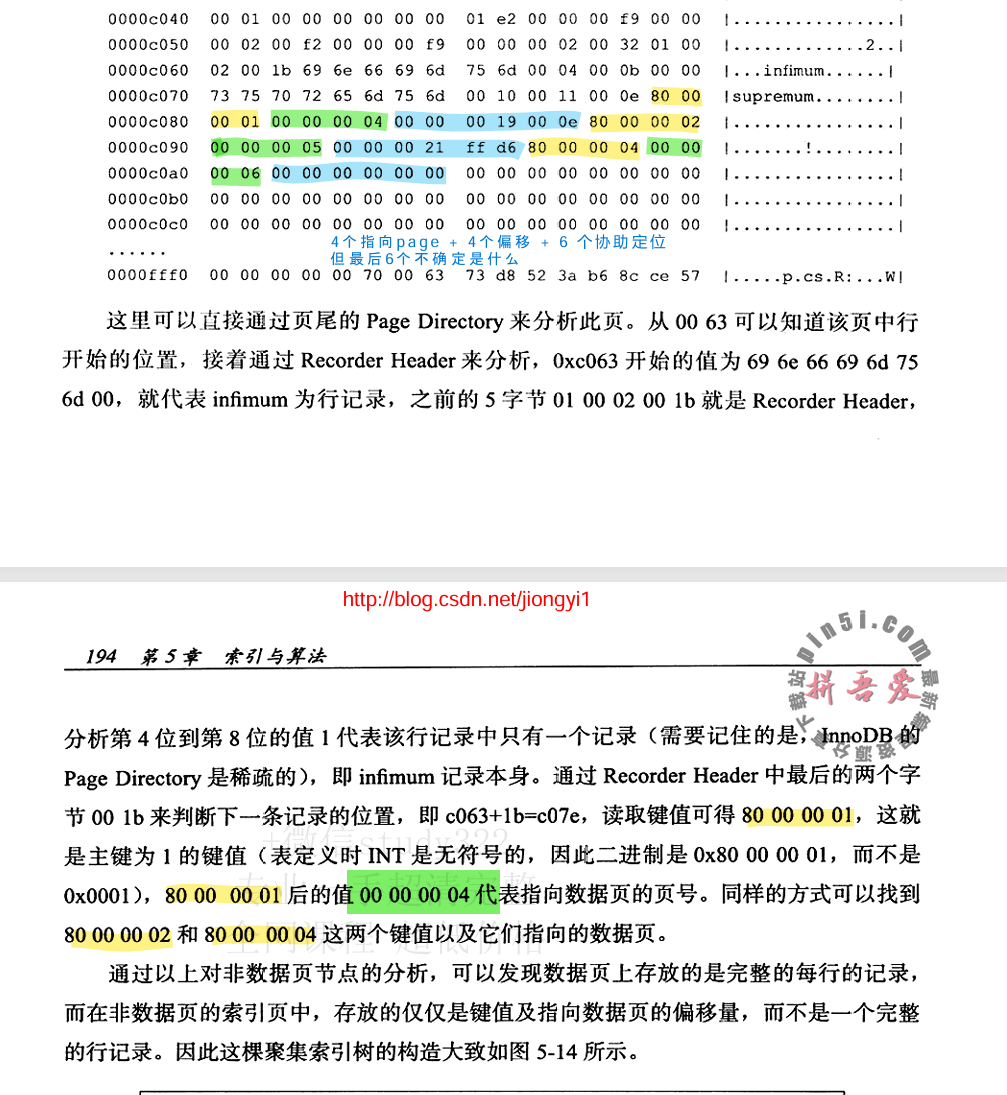Mysql单表存储不要超过2kw?
有不少文章在解释,Mysql单表最好不要超过2kw,了解时感觉头头是道实际上漏洞百出经不起推敲。有的人甚至会说Mysql指针大小是6,有的又说是12,搞的一塌糊涂根本不知道什么是什么,怪的很。但最终他们的结论是对的,实在有点难绷,为了避免以后又被这群人搞懵导致记错,写一个简单的笔记记录以下正确的推导过程。
他们的实际依据其实就是当B+树的层数增加,会导致Mysql搜索的性能下降。那只要知道层转换的时候,数据量大概是多少就能判断他们的这个结论是否正确。
前提信息
首先,我们知道实际上我们的数据在My ql之中其实是存储在B+树上的,而在实际的物理结构之中,其实是存储由C++写的Mysql Innodb(默认),引擎定义的一种结构下,该结构被称之为数据页。数据页的大小实际上由 my.ini 中的配置项 innodb_page_size 来限制的 (补充一点,数据行的大小限制也与它有关系,默认的情况下一行的数据最大大小不能超过一个数据页的一半,也就是8192k的来源 [实际上的大小会比该值小,因为还有其他的一些原因,比如记录数据的类型、varchar开始结束的两个固定表达范围的字节等])
The maximum row size for an
InnoDBtable, which applies to data stored locally within a database page, is slightly less than half a page for 4KB, 8KB, 16KB, and 32KBinnodb_page_sizesettings. For example, the maximum row size is slightly less than 8KB for the default 16KBInnoDBpage size. For 64KB pages, the maximum row size is slightly less than 16KB.MySQL :: MySQL 8.0 Reference Manual :: 10.4.7 Limits on Table Column Count and Row Size
Command-Line Format --innodb-page-size=#System Variable innodb_page_sizeScope Global Dynamic No SET_VARHint AppliesNo Type Enumeration Default Value 16384Valid Values 4096``8192``16384``32768``65536Specifies the page size for
InnoDBtablespaces. Values can be specified in bytes or kilobytes. For example, a 16 kilobyte page size value can be specified as 16384, 16KB, or 16k.MySQL :: MySQL 8.0 Reference Manual :: 17.14 InnoDB Startup Options and System Variables
不管如何,总的来说,我们可以依靠这点大概知道一个信息,也就是默认情况下 innodb_page_size 大小是16k,而实际上我们的数据保存在其中的 User Records 之中。实际上我们可以存储的大小应该在13-16k左右。接下来的计算以16k作为基准。
User Records 可用空间 = 16384 - 38 File Header - 56 Page Header - 26 Infimum Supermum - 8 File Trailer - 页目录大小 Page Directory - 必要空闲空间
File_Header 组成部分:MySQL: Fil_page_header Struct Reference
在B+树结构的学习上,我们知道B+树非叶子节点不需要记录本身,而是只记录键值对,实际上就是主键 + 指针信息,根据常识C++中的指针是4个字节。而主键在默认的自增主键大小的情况下是8个字节。实际上还需要外加6个字节协助定位。
索引信息由 4指针 + 4PageNo + 6辅助字节 组成的来源
Mysql源码返回数据页节点指针信息 (基于C++底层实现)
/**********************************************************************//** Builds a node pointer out of a physical record and a page number. @return own: node pointer */ dtuple_t* dict_index_build_node_ptr( /*======================*/ const dict_index_t* index, /*!< in: index */ const rec_t* rec, /*!< in: record for which to build node pointer */ ulint page_no,/*!< in: page number to put in node pointer */ mem_heap_t* heap, /*!< in: memory heap where pointer created */ ulint level) /*!< in: level of rec in tree: 0 means leaf level */ { dtuple_t* tuple; dfield_t* field; byte* buf; ulint n_unique; if (dict_index_is_ibuf(index)) { /* In a universal index tree, we take the whole record as the node pointer if the record is on the leaf level, on non-leaf levels we remove the last field, which contains the page number of the child page */ ut_a(!dict_table_is_comp(index->table)); n_unique = rec_get_n_fields_old(rec); if (level > 0) { ut_a(n_unique > 1); n_unique--; } } else { n_unique = dict_index_get_n_unique_in_tree_nonleaf(index);// 唯一定位 到叶子节点的字段个数 } tuple = dtuple_create(heap, n_unique + 1); //建立元组 /* When searching in the tree for the node pointer, we must not do comparison on the last field, the page number field, as on upper levels in the tree there may be identical node pointers with a different page number; therefore, we set the n_fields_cmp to one less: */ dtuple_set_n_fields_cmp(tuple, n_unique); //比较字段为 数据域 dict_index_copy_types(tuple, index, n_unique); //进行类型复制 buf = static_cast<byte*>(mem_heap_alloc(heap, 4)); //分配内存 mach_write_to_4(buf, page_no);//写入 叶子节点page no field = dtuple_get_nth_field(tuple, n_unique); //字段个数 能够唯一定位的字段个数 dfield_set_data(field, buf, 4);//写入字段个数 dtype_set(dfield_get_type(field), DATA_SYS_CHILD, DATA_NOT_NULL, 4); rec_copy_prefix_to_dtuple(tuple, rec, index, n_unique, heap); //复制数据 dtuple_set_info_bits(tuple, dtuple_get_info_bits(tuple) | REC_STATUS_NODE_PTR); ut_ad(dtuple_check_typed(tuple)); return(tuple); }除了指针以外,6个字节 协助定位 已经查阅资料 参考定位。----- 《MySQL技术内幕:InnoDB存储引擎》- 193页到194页
验证计算
到这里,我们就可以开始计算了。
当B+树只有一层的时候,假设一行数据的大小是1K,一层最多存储16条数据 (其实就是一个数据页)
(16k / 1k)= 16
当B+树有两层的时候,假设一行数据的大小是1K。
第一层的数据页最多记录数据页数量 * 第二行数据页记录数据量。大概就是1w8数据。
(16k / 14) * (16k / 1k)= 1142.857 * 16 = 18,285.714
当B+树有三层的时候,假设一行数据的大小是1K
(16k / 14)^2 * (16k / 1k)= 20,897,953.9591 ≈ 2kw
实际的结果是,2kw是对的,但如果要跟别人说自己的结论,需要记上以下关键信息:
- 实际每一个节点都是数据页
- 一个数据页的大小是16k,去掉其他已知大小部分之后,存放数据的user_records还是16k。
- 非叶子结点记录的索引信息是 4 + 4 + 6 14个字节
- 一个数据页最多可以存储1142个子数据页的索引信息 (下层节点最多数量)
- 假设一行大小是1k的情况下,三层可以存储大概在2.08kw条数据

